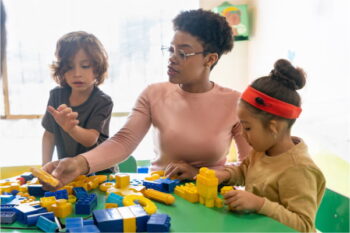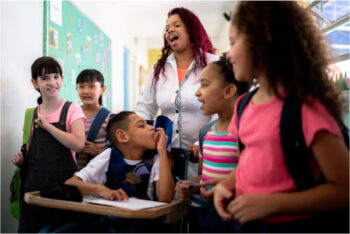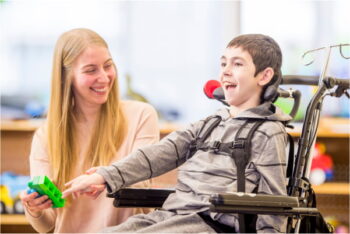What Is Special Education?
 Special education is a program of instruction that educators design to address the unique needs of a specific student with a disability. This includes any related services the student needs to participate in their program, such as transportation and mobility services. Students attending public schools receive special education services for free.
Special education is a program of instruction that educators design to address the unique needs of a specific student with a disability. This includes any related services the student needs to participate in their program, such as transportation and mobility services. Students attending public schools receive special education services for free.
At the heart of special education is the Individuals With Disabilities Education Act (IDEA). This federal law guarantees that eligible students with disabilities receive a Free Appropriate Public Education (FAPE).
Navigating Special Education Services
Indeed, the special education system can be overwhelming to parents who are just starting to navigate it. Between the many acronyms and the sheer volume of information, it is common for parents to feel overwhelmed or lost.
The good news is that there are several resources available to help you ensure that your child is getting the best education possible. If you have questions or concerns, your child’s teacher, counselor, or principal should be able to help.
- Center for Parent Information & Resources: This hub of information was created for the network of Parent Training and Information Centers (PTIs) and Community Parent Resource Centers (CPRCs), which serve families of children with disabilities.
- CPRCs and PTIs: There are nearly 100 of these centers spread across the country. Visit the Parent Center locator page to find the PTI or CPRC for your community.
- National birth injury or disability groups: Organizations such as the Federation for Children With Special Needs, PACER Center, and United Cerebral Palsy have resources pertaining to special education.
- Office of Special Education: Additionally, each state and U.S. territory has an Office of Special Education. Contact the special education agency where you live.
- The Center for Appropriate Dispute Resolution in Special Education (CADRE): This government-funded group provides information aimed at helping families prevent and resolve disputes in special education.
- U.S. Department of Education: The department’s IDEA website has resources and information for parents of students with disabilities.
- Wrightslaw: This website, founded by special education attorneys, examines special education issues from a legal perspective.
Read on to learn about some of the other terms you’ll likely encounter as you advocate for services for your child. It may seem like alphabet soup at first, but we know you’ll be a pro in no time.
Learning the Lingo
Individualized Education Program (IEP)
Special education services are provided to students according to a written plan called an IEP. Think of the IEP as a blueprint that maps out the student’s instructional program, learning goals, and supports they need to succeed. Children can have an IEP in any grade — from pre-K through high school.
An IEP team consisting of teachers, a school district representative, and the child’s parents or guardians will create an IEP tailored to the child’s abilities and needs. You are a crucial part of this team as the person who knows your child best.
Individualized Family Service Plan (IFSP)
IFSPs outline early intervention services for infants and toddlers who are showing signs of developmental delays. These plans are available for children three years and under who experience cognitive, communicative, emotional, physical, and/or social impairments.
IFSPs differ from IEPs because they address the future needs of young children and emphasize the importance of including the family in these goals. In writing the ISFP, the team focuses on the concept that the family is the child’s greatest asset.
Least Restrictive Environment (LRE)
 One of the main principles of special education is that students with disabilities should be included in the general education environment as much as possible and only removed if education with support services cannot be achieved. This is referred to as the least restrictive environment. The IEP team determines the LRE.
One of the main principles of special education is that students with disabilities should be included in the general education environment as much as possible and only removed if education with support services cannot be achieved. This is referred to as the least restrictive environment. The IEP team determines the LRE.
Other Health Impairment (OHI)
Other health impairment is a disability category under the IDEA that includes a broad range of chronic and acute health problems such as asthma, attention deficit disorder (ADD), attention deficit hyperactivity disorder (ADHD), diabetes, and leukemia. The student must have “limited strength, vitality, or alertness” and their educational performance must be affected to qualify for special education services.
Section 504 Plan
Section 504 plans are programs that allow children with disabilities to learn in public schools alongside their peers. A student who does not qualify for services under the IDEA may qualify for 504 services, which are required by regulations under Section 504 of the Rehabilitation Act of 1973.
Unlike IEPs, 504 plans do not provide individualized instruction or special education. Section 504 accommodations may include extra time on tests, speech-language therapy, study skills classes, and the opportunity to leave the classroom for short breaks.
The Office for Civil Rights has helpful information on how the IDEA and Section 504 work together to help students with disabilities.
Related Special Education Services
The IEP team determines the related services that a child needs to help them benefit from their special education program. A child may qualify for one or more of these related services based on their disability and related needs.
Occupational Therapy (OT)
Occupational therapy is a type of therapy that uses everyday activities — or occupations — to treat a person’s ability to perform ordinary tasks. OT in a school setting equips students with skills to interact with their school’s curriculum.
Some occupational therapists work with teachers and parents to create a therapy plan. Materials such as paper, clay, scissors, chalk, blocks, and puzzles are often used to improve a child’s fine motor skills.
- Ask your child’s pediatrician
- Check with your child’s school nurse
- Visit the American Occupational Therapy Association website to get contact information for your state’s branch
Physical Therapy (PT)
Some children receive physical therapy in school as part of their IEP. In school-based PT, physical therapists use various therapeutic activities to help students access their educational environment.
For example, a child might receive PT to improve their handwriting or help them safely navigate school stairs. Children with cerebral palsy and muscular dystrophy may benefit from PT.
As noted above, your child’s pediatrician or school nurse may be able to help you find a qualified physical therapist.
The American Physical Therapy Association has a searchable directory that can help you locate PT specialists near you.
Recreational Therapy
Recreational therapy uses recreation and activity-based activities to help students with disabilities participate in leisure and play activities as independently as possible. This may allow them to benefit from the social parts of school.
Some recreational therapy techniques include:
- Dancing to music
- Drawing with sidewalk chalk
- Painting on large pieces of paper
- Playing bingo, board games, or card games
This type of therapy may be provided in school or outside of school in parks, summer camps, or other settings.
Special Education Aides
 Special education aides generally work in small group settings with children with disabilities to help improve their behavior, emotional/communication skills, and more. They often work with special education teachers and therapists to create a plan that fits the child’s needs.
Special education aides generally work in small group settings with children with disabilities to help improve their behavior, emotional/communication skills, and more. They often work with special education teachers and therapists to create a plan that fits the child’s needs.
Speech-Language Therapy
Many children with birth injuries have trouble speaking. Speech-language therapy helps children communicate with others more effectively.
Sign language, hearing aids, communication devices, computer programs, and oral muscle exercises can all be used to help children communicate.
Other Related Services
These are only a few of the related services available to eligible students with disabilities. Some students, for example, receive transportation, counseling, and school nurse services. The IDEA provides a detailed listing of related services.
Public Schools Versus Specialized Schools
When deciding on schools for your child, you may wonder whether they would do best at a public or specialized school for children with disabilities. As with most things in life, there are pros and cons.
Certainly, one substantial positive aspect of public schools is that they are free. Additionally, they are legally required to teach your child, unlike private schools.
However, many public schools are underfunded and can be complex places for students with special needs to navigate.
Many children with disabilities thrive at private schools. Schools that cater to students with general or specific disabilities can be expensive, but your school district may be obligated to pay for private tuition if you can show that the district cannot provide your child with a FAPE.
Additionally, there are many scholarships available for children with disabilities that can be used to help pay for private elementary or secondary education or even higher education costs. For example, national disability organizations such as United Cerebral Palsy and its local chapters are known for awarding scholarships.
A college advisor may be able to help you find disability scholarships for higher education opportunities. Your local health care provider, school counselor, or nonprofit organization will likely have a list of available elementary or secondary education scholarships.
Homeschooling Children with Learning Disabilities
Many parents of children with disabilities opt for homeschooling. Homeschooling may be the best option if you believe that public schools cannot provide your child with the right amount of attention and resources for academic growth and success.
 Many homeschooled children with learning disabilities are using online learning options. Parents homeschooling their children can help them with the pace, presentation, and instruction of online learning. This level of customization can create a personalized learning experience best suited for your child.
Many homeschooled children with learning disabilities are using online learning options. Parents homeschooling their children can help them with the pace, presentation, and instruction of online learning. This level of customization can create a personalized learning experience best suited for your child.
In some states, homeschooled students with disabilities qualify for special education services provided by their school district. Check with your local school district to find out the rules in your state.
The Home School Legal Defense Association and Homeschool.com has a wealth of resources available for parents educating children with special needs at home.
How to Access Special Education Resources
If you think your child could benefit from special education services, you can ask the school to evaluate your child. You can do this by calling or writing to the school principal or director of special education for your school district.
If you are looking to enroll your child in a specialized school for children with disabilities, reach out to the institution to see if your child qualifies.
If you are interested in homeschooling your child, make sure you do your research and learn about the rules in your state.
Remember, your child deserves a quality education. Special education offers children with disabilities the opportunity to learn and grow into happy and productive adults.
If you believe your child is not receiving the services they need to succeed, speak up. Don’t be afraid to ask questions, voice your concerns, or ask for help.
As noted above, there are many resources available to help you navigate the special education system and obtain the best possible education for your child.


